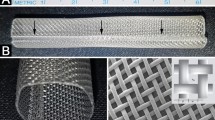Summary
The main problem with urinary diversion via cutaneous ureterostomy is stomal stenosis. Results with experimental and clinical implants of carbon polymer stoma prostheses (max. clinical observation period: 31 months) for vesicostomies have encouraged us to find out whether implants of this material would be suitable for cutaneous ureterostomies as well. The first step was dilatation of the ureters in 16 mongrel dogs, 4 mini pigs and 4 sheep. This was done by knotting a thread over a splint which had been introduced into the ureter. After 7 days the ureter was ligated prevesically and a carbon polymer stoma was implanted into the ureter.
37 of the 48 stoma implants were well tolerated and provided water tight urinary drainage; slight encrustation occurred but, radiologically, a smooth flow of contrast medium was seen. Ten of these 37 cases had transient urinary leakage. Eleven of the 48 stoma implants were unsuccessful because of insufficient healing, urinary extravasation, parastomal inflammation or severe encrustations.
The results of these experiments on animals would seem to justify initial clinical use. It is conceiveable that in this way stomal stenosis of the cutaneous ureterostomy can be avoided.
Similar content being viewed by others
References
Harzmann, R., Bichler, K.-H., Ideler, V.: The use of pure carbon stomata (Biocarbon) in urinary diversion. British Journal of Urology 50, 485 (1978)
Harzmann, R., Bichler, K.-H., Kieninger, G., Haumer, M., Ideler, V.: Tierexperimentelle und klinische Erfahrungen mit Kohlenstoffpolymerstomata. Helvetica Chirurgia Acta 45, 355 (1978)
Hauri, D., Ackermann, R., Osterhage, H.R., Leisinger, H.J.: Ist Urinkontinenz bei Ileumund Sigma-Conduits mittels autologer freier Transplantate aus glatter Darmmuskulatur zu erzielen? 5. Symposium für experimentelle urologie, Zürich, April 1980
Jurkovic, K., Schwarzhaupt, W.: Alloplastische Stomaprothese beim Sigma Conduit. Verhandlungen der Deutschen Gesellschaft für Urologie 24, (1973)
Leisinger, H.J., Sulmoni, A., Hauri, D., Schmucki, O., Uhlschmid, G.: Resultate der kontinenten Ileumblase beim Hund. Verhandlungen der Deutschen Gesellschaft für Urologie 25, 271 (1974)
Mooney, V., Hartmann, D.B., McNeal, D.: The use of pure carbon for permanent percutaneous electrical comector systems. Archives of Surgery 108, 148 (1974)
Rodeck, G., Rössner, N.: Die transureterale Ureterocutaneostomie — Eine Alternative zum Conduit? Verhandlungen der Deutschen Gesellschaft für Urologie 30, 422 (1979)
Schmidt, E., Bruch, H.P., Greulich, M., Rothhammer, A., Romen, W.: Kontinente Colostomie durch freie Transplantation autologer Dickdarmmuskulatur. Chirurg 50, 96 (1979)
Schreiter, F., Orestano, R., Kraus, F., Laese, W., Planz, K.: Eine einfache Technik zur Herstellung einer partiellen Stenose am Kaninchen-Harnleiter mit vorausbestimmbarem Grad der Stauung. Urologe A 11, 230 (1972)
Author information
Authors and Affiliations
Rights and permissions
About this article
Cite this article
Harzmann, R., Kobashi, L.I., Raible, D.A. et al. Experimental data on the application of a stoma prothesis in cutaneous ureterostomy. Urol. Res. 9, 175–180 (1981). https://doi.org/10.1007/BF00264823
Accepted:
Issue Date:
DOI: https://doi.org/10.1007/BF00264823




